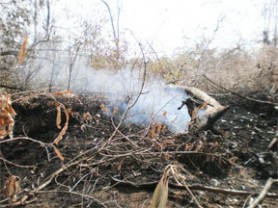A quick response from the Guyana Fire Service yesterday limited the damage done to the mangrove trees which make up the Hope Beach Black Mangrove Forest, on the East Coast Demerara.
Yesterday’s fire is the second to strike the area in three days, raising concerns as to whether the trees were deliberately set ablaze.

On Thursday afternoon, the Fire Service was summoned to the site to extinguish fires that had erupted in a section of the forest. The mangroves burnt in yesterday’s fire were only feet away from those burnt during Thursday’s fire.
Around 1.30 pm yesterday, heavy smoke was seen emanating from a section of the Mangrove Forest which is said to cover an area of about 1,200 by 300 feet. The Fire Service’s quick response enabled the blaze to be contained before it spread. Investigations into the cause of the two fires have now begun.
Director of the National Agricultural Research Institute (NARI) Dr Oudho Homenauth was on the scene yesterday and he commended the Fire Service’s prompt and effective response. He said the affected plants are more than 20 years old and form an integral part of the country’s sea defence. Calling the mangroves “very, very precious assets”, he noted that destroying mangroves was now a criminal offence and pledged that action would be taken against anyone suspected of doing such.
Homenauth explained to this newspaper that the wood from mangroves is often used by persons to make bricks as well as to serve the purpose of firewood.
Meanwhile, Annette Arjoon- Martins, Chairman of the Mangrove Action Committee, also praised the Fire Service’s effective action. She said that some 15 mangrove trees had been destroyed in the fire. She, too, highlighted the importance of mangroves, particularly to the fishing sector. According to her, fishes usually spawn their eggs at mangrove trees.
Arjoon-Martins said the population needed to be taught about mangroves and an aggressive public awareness campaign will begin shortly.
Government has been pushing for the preserving and planting of mangroves and has announced a plan to spend around $125 million for the year on restoration projects across the coastland. This initiative is linked to the country’s Low Carbon Development Strategy.




